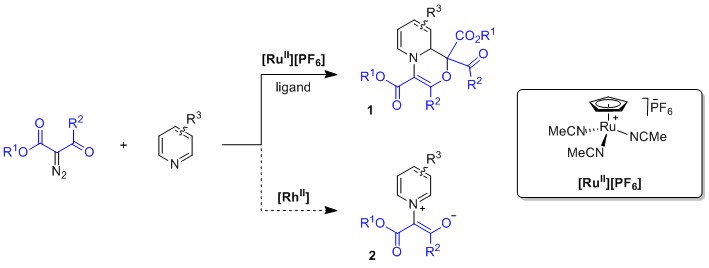CpRu-Catalyzed Pyridine Dearomatization Through Double Carbene Insertions
CpRu complexes are interesting alternatives to copper and dirhodium species for the metal-catalyzed decomposition of diazo compounds.[1] In this context, it has been shown that combinations of [CpRu(CH3CN)3][PF6] and diimine ligands react catalytically with α-diazo-β-ketoesters and allow subsequent condensation, OH and 1,3-CH insertion reactions.[2] Recently, using this catalytic combination, new dioxene motifs were synthetized by enantiospecific syn-opening of epoxides.[3]
In a new development that uses electron-poor pyridines and quinolines as substrates, the direct formation of original oxazine moieties 1 is described. Reactions proceed by tandem (double) additions of carbenes and a dearomatization of the azaaromatics. Such a process occurs primarily via ruthenium cyclopentadienyle catalysis since, under Rh(II)-mediated reactions, pyridinium ylides 2 are the major adducts.[4] Mechanistic insights will be also presented.

[1] a) Walter Baratta, Alessandro Del Zotto, Pierluigi Rigo, Chemical Communications 1997, 2163; b) Walter Baratta, Wolfgang A. Herrmann, Roland M. Kratzer, Pierluigi Rigo, Organometallics 2000, 19, 3664.
[2] a) Martina Austeri, Diane Rix, Walid Zeghida, Jérôme Lacour, Organic Letters 2011, 13, 1394; b) Cecilia Tortoreto, Thierry Achard, Walid Zeghida, Martina Austeri, Laure Guénée, Jérôme Lacour, Angewandte Chemie International Edition 2012, 51, 5847.
[3] Thierry Achard, Cecilia Tortoreto, Amalia I. Poblador-Bahamonde, Laure Guénée, Thomas Bürgi, Jérôme Lacour, Angewandte Chemie International Edition 2014, 53, 6140.
[4] a) Albert Padwa, David J. Austin, Laura Precedo, Lin Zhi, The Journal of Organic Chemistry 1993, 58, 1144; b) Albert Padwa, M. David Weingarten, Chemical Reviews 1996, 96, 223.